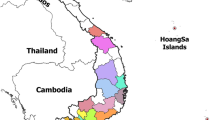Abstract
Classical swine fever (CSF), a highly contagious viral disease affecting domestic and wild pigs in many developing countries, is now considered endemic in Mongolia, with 14 recent outbreaks in 2007, 2008, 2011, 2012, 2014, and 2015. For the first time, CSF viruses isolated from these 14 outbreaks were analyzed to assess their molecular epidemiology and pathogenicity in pigs. Based on the nucleotide sequences of their 5′-untranslated region, isolates were phylogenetically classified as either sub-genotypes 2.1b or 2.2, and the 2014 and 2015 isolates, which were classified as 2.1b, were closely related to isolates from China and Korea. In addition, at least three different viruses classified as 2.1b circulated in Mongolia. Experimental infection of the representative isolate in 2014 demonstrated moderate pathogenicity in 4-week-old pigs, with relatively mild clinical signs. Understanding the diversity of circulating CSF viruses gleans insight into disease dynamics and evolution, and may inform the design of effective CSF control strategies in Mongolia.



Similar content being viewed by others
References
B.D. Lindenbach, C.L. Murray, H.J. Thiel, C.M. Rice, in Fields Virology, 6th ed. By D.M. Knipe, P.M. Howley (Wolters Kluwer/Lippincott Williams & Wilkins Health, Philadelphia, 2013), pp. 712–794
V. Moennig, G. Floegel-Niesmann, I. Greiser-Wilke, Vet. J. 165, 11–20 (2003)
The World Organization for Animal Health, Manual of Diagnostic Tests and Vaccines for Terrestrial Animals “Classical swine fever (hog cholera)”, (2016) http://www.oie.int/fileadmin/Home/eng/Health_standards/tahm/2.08.03_CSF.pdf. Accessed 6 October 2016
The World Organization for Animal Health, World Animal Health Information Database (WAHIS) Interface, http://www.oie.int/wahis_2/public/wahid.php/Diseaseinformation/Diseasetimelines. Accessed 16 October 2016
A. Postel, S. Schmeiser, J. Bernau, A. Meindl-Boehmer, G. Pridotkas, Z. Dirbakova, M. Mojzis, P. Becher, Vet. Res. 43, 50 (2012)
D.J. Paton, A. McGoldrick, I. Greiser-Wilke, S. Parchariyanon, J.Y. Song, P.P. Liou, T. Stadejek, J.P. Lowings, H. Bjorklund, S. Belak, Vet. Microbiol. 73, 137–157 (2000)
M. Beer, K.V. Goller, C. Staubach, S. Blome, Anim. Health Res. Rev. 16, 33–39 (2015)
Y. Luo, S. Li, Y. Sun, H.J. Qiu, Vet. Microbiol. 172, 1–6 (2014)
S. Edwards, A. Fukusho, P.C. Lefevre, A. Lipowski, Z. Pejsak, P. Roehe, J. Westergaard, Vet. Microbiol. 73, 103–119 (2000)
Y. Sakoda, A. Fukusho, In Vitro Cell. Dev. Biol. Anim. 34, 53–57 (1998)
T. Tamura, Y. Sakoda, F. Yoshino, T. Nomura, N. Yamamoto, Y. Sato, M. Okamatsu, N. Ruggli, H. Kida, J. Virol. 86, 8602–8613 (2012)
L. Reed, H. Muench, Am. J. Hyg. 27, 493–497 (1938)
S. Vilcek, T. Stadejek, A. Ballagi-Pordany, J.P. Lowings, D.J. Paton, S. Belak, Virus Res. 43, 137–147 (1996)
S. Kumar, G. Stecher, K. Tamura, Mol. Biol. Evol. 33, 1870–1874 (2016)
K. Tamura, M. Nei, Mol. Biol. Evol. 10, 512–526 (1993)
Y.K. Kim, S.I. Lim, J.J. Kim, Y.Y. Cho, J.Y. Song, I.S. Cho, B.H. Hyun, S.H. Choi, S.H. Kim, E.H. Park, D.J. An, J. Vet. Med. Sci. 77, 1667–1671 (2016)
C. Lv, Q. Yang, X. Gao, Y. Yao, X. Li, Y. Xiao, K. Tian, Genom Announc. 4, e00093 (2016)
W. Gong, J. Wu, Z. Lu, L. Zhang, S. Qin, F. Chen, Z. Peng, Q. Wang, L. Ma, A. Bai, H. Guo, J. Shi, C. Tu, Infect. Genet. Evol. 41, 218–226 (2016)
T.R. Luo, S.H. Liao, X.S. Wu, L. Feng, Z.X. Yuan, H. Li, J.J. Liang, X.M. Meng, H.Y. Zhang, Virus Genes 42, 347–354 (2011)
V. Kaden, U. Ziegler, E. Lange, J. Dedek, Berl. Munch. Tierarztl. Wochenschr. 113, 412–416 (2000)
T. Tamura, N. Nagashima, N. Ruggli, A. Summerfield, H. Kida, Y. Sakoda, Vet. Res. 45, 47 (2014)
S.I. Lim, Y.K. Kim, J.A. Lim, S.H. Han, H.S. Hyun, K.S. Kim, B.H. Hyun, J.J. Kim, I.S. Cho, J.Y. Song, S.H. Choi, S.H. Kim, D.J. An, J. Vet. Sci., in press
Y. Luo, S. Ji, Y. Liu, J.L. Lei, S.L. Xia, Y. Wang, M.L. Du, L. Shao, X.Y. Meng, M. Zhou, Y. Sun, H.J. Qiu, Transbound. Emerg. Dis., in press
I. Leifer, N. Ruggli, S. Blome, Virology 438, 51–55 (2013)
Acknowledgements
We would like to thank the Bulgan, Selenge, and Dornod provincial veterinary laboratories and the General Agency of Specialized Investigation of Mongolia for support. We also thank Ms. N. Fukushi, Graduate School of Veterinary Medicine, Hokkaido University, for her assistance with sequencing.
Author's contribution
B.E. performed RT-PCR and sequencing. M.S., S.W., and T.T. performed animal experiments and virus isolation. T.H., K.M., and M.O. provided laboratory management support and manuscript editing. T.U. and B.D. designed this research project and supported epidemiological and pathological experiments. Y.S. performed the phylogenetic tree analysis and managed this research project. All authors read and approved the final manuscript.
Funding
This study was funded by Hokkaido University and the Japan International Cooperation Agency (JICA).
Author information
Authors and Affiliations
Corresponding author
Ethics declarations
Conflict of interest
The authors declare they have no conflict of interest.
Ethical approval
All applicable international, national, and/or institutional guidelines for the care and use of animals were followed. The Graduate School of Veterinary Medicine, Hokkaido University has the accreditation of the Association for Assessment and Accreditation of Laboratory Animal Care International (AALAC International) since 2007.
Additional information
Edited by Keizo Tomonaga.
Rights and permissions
About this article
Cite this article
Enkhbold, B., Shatar, M., Wakamori, S. et al. Genetic and virulence characterization of classical swine fever viruses isolated in Mongolia from 2007 to 2015. Virus Genes 53, 418–425 (2017). https://doi.org/10.1007/s11262-017-1442-2
Received:
Accepted:
Published:
Issue Date:
DOI: https://doi.org/10.1007/s11262-017-1442-2




